A Thing of Beauty _|_ Issue 13, 2019
A Thing of Beauty…
Jane Clark contemplates the view of Earth from the moon, first captured in the famous photograph ‘Earthrise’
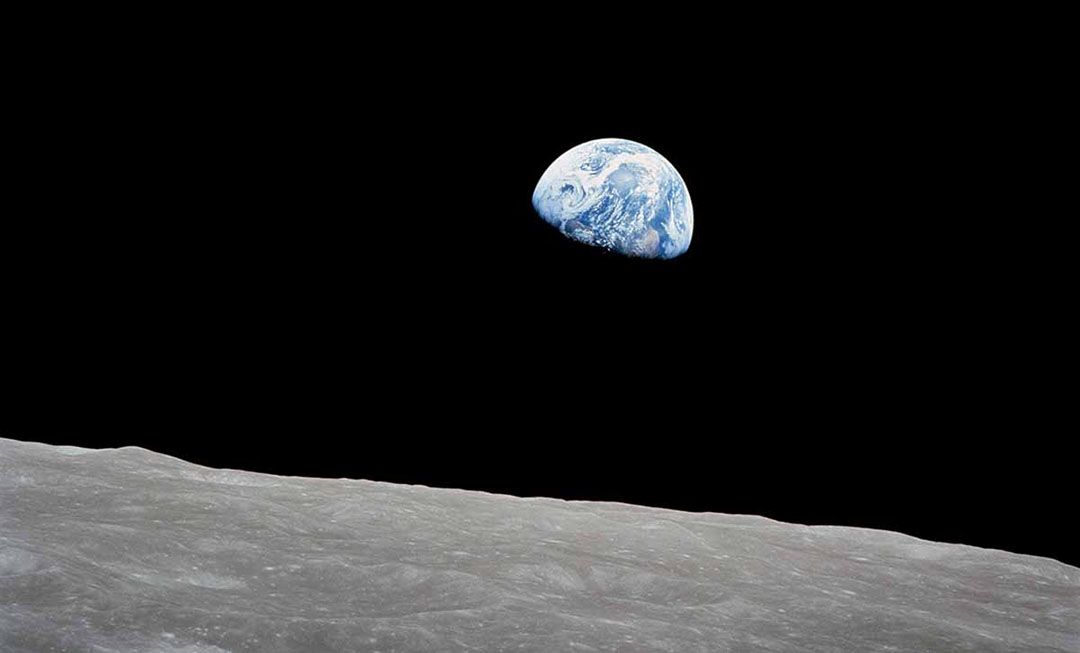
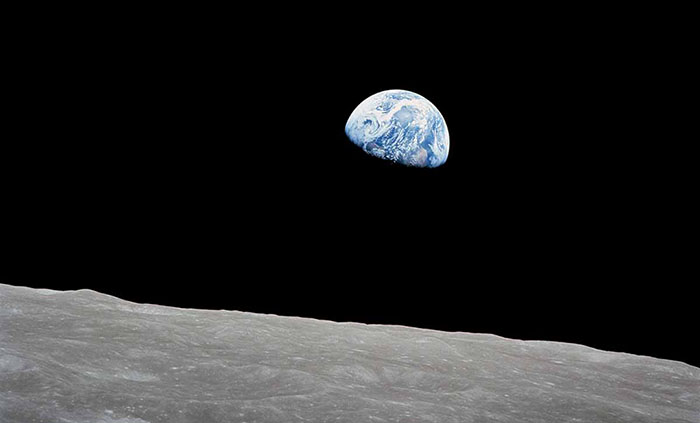
A Thing of Beauty…
Jane Clark contemplates the view of Earth from the moon, first captured in the famous photograph ‘Earthrise’
Fred Hoyle, the British astronomer, said: “Once a photograph of the earth, taken from outside, is available, a new idea as powerful as any in history will be let loose.” Twenty years later, such a photograph was taken by the Apollo 8 mission. Jane Clark assesses the impact it has had upon our understanding of ourselves and the world, looking particularly at the experiences of the 500-plus astronauts who have now viewed our planet from space. In the process, she discovers a new psychological phenomenon – ‘the overview effect’.
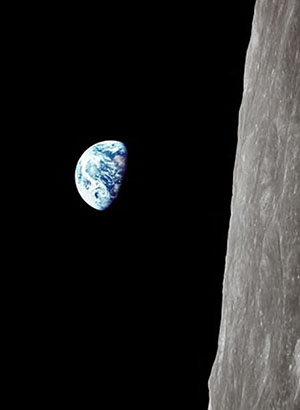 This spectacular image of Earth rising on the horizon of the moon was taken on Christmas Eve 1968 by the Apollo 8 space mission. Released by NASA a few days later, it instantly took on iconic status. It was the first picture ever taken of our whole planet from ‘outside’ and has become one of the most powerful symbols of our age.
This spectacular image of Earth rising on the horizon of the moon was taken on Christmas Eve 1968 by the Apollo 8 space mission. Released by NASA a few days later, it instantly took on iconic status. It was the first picture ever taken of our whole planet from ‘outside’ and has become one of the most powerful symbols of our age.
It is ironic, therefore, that it was a completely unplanned result of the mission. There is even some question about which of the three crew members – Frank Borman, Jim Lovell and Bill Anders – took the shot. Generally, it has been attributed to lunar module pilot Bill Anders on his Hasselblad handheld camera. He has explained:
One of my assignments was to photograph the lunar surface to facilitate the evaluation of potential landing sites. I brought a 250 mm lens to bring that alien terrain into better view. On our fourth orbit, the spacecraft was oriented in a different direction. A startling image captivated the three of us – Earth, 238,900 miles away, ascended above the barren lunar surface.
Compelled by that vision, we scrambled for cameras. I deviated from the rigid NASA flight plan. Every photographic exposure had been determined in advance but I had to capture our view with the long lens on color film. [1]
Recordings of the mission reveal that the first image was actually taken in black and white (see video right or below), but it was Anders’ colour version that was eventually chosen by NASA for distribution. The image was doctored before release to increase the dramatic effect. The view seen by the crew was of the Earth to the side of the moon, not above it, and it was tiny – the size of a small marble. NASA changed the orientation so that Earth seemed to be rising above the moon’s horizon, and the area of lunar landscape was then reduced to make it look bigger and hence more important. [2]
Video: Earthrise: The Story Behind William Anders’ Apollo 8 Photograph. 5:04 minutes
But whichever way you look at it, the view is compelling. No one had expected it. The attention of the mission was directed outwards, to the new worlds opening up to human exploration, but the astronauts soon tired of the moon’s surface, which was grey and lifeless. The vision of Earth, by contrast, was riveting. Anders was later to famously remark:
We went to the moon, but what we really discovered was the planet Earth.
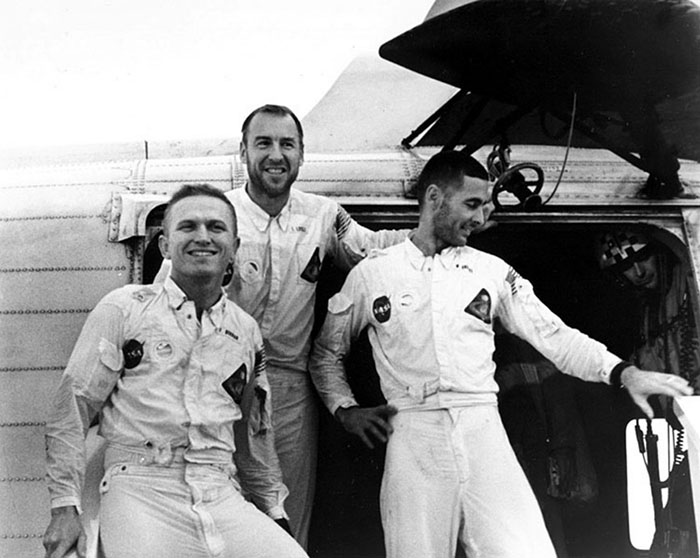
The crew of Apollo 8, stepping off the helicopter onto the deck of the US aircraft carrier Yorktown on their return home: William Anders (right), James Lovell (centre) Frank Borman (left). Photograph: NASA
Beauty and Unity
.
The original power of the image has perhaps diminished over the past fifty years. But viewing Earth from ‘above’ has not lost its attraction for the many astronauts – around 570 to date – who have experienced it first hand. [3] During the first eight missions of the International Space Station, for instance, almost 200,000 photographs of Earth were taken, most of them (over 80%) by crew. And when the members of the Skylab IV crew were denied the time to contemplate it because of excessive workload, they downed tools and rebelled, maintaining that they had “a need to reflect, to observe, to find their place amidst these baffling, fascinating, unprecedented experiences”. [4]
So what is it that is so inspiring about looking back at our planet?
Well, the most obvious answer is that it is beautiful: bright, colourful and palpably alive against the black backdrop of seemingly infinite space. Edgar Mitchell, an astronaut on the Apollo 14 mission (1971), and the sixth person to walk on the surface of the moon, describes it like this:
Suddenly, from behind the rim of the moon, in long, slow-motion moments of immense majesty, there emerges a sparkling blue and white jewel, a light, delicate, sky-blue sphere laced with slowly swirling veils of white, rising gradually like a small pearl in a thick sea of black mystery. It takes more than a moment to fully realize this is Earth… home. [5, page 138]
whilst James Irwin on Apollo 15 (1972) tells us:
The Earth reminded us of a Christmas tree ornament hanging in the blackness of space. As we got further and further away, it diminished in size. Finally it shrank to the size of a marble, the most beautiful marble you can imagine. That beautiful, warm living object looked so fragile, so delicate, that if you touched it with a finger it would start to crumble. Seeing this has to change a man. [5, page 38]
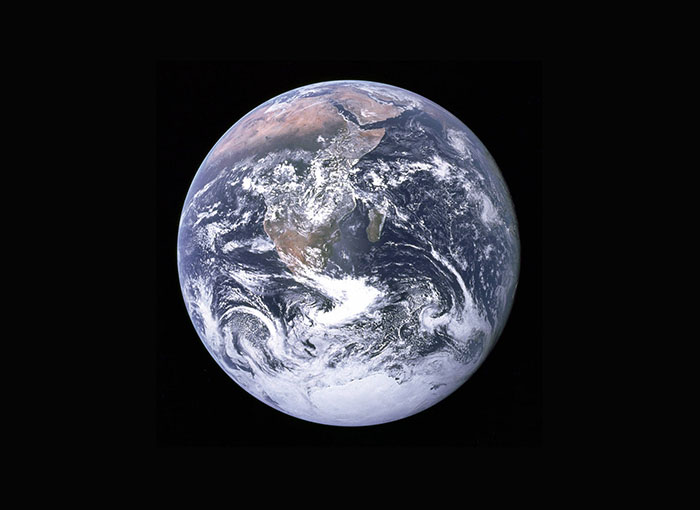
The Blue Marble. View of the Earth as seen by the Apollo 17 crew travelling toward the moon in 1972. This translunar coast photograph extends from the Mediterranean Sea area to Antarctica. It was the first time the Apollo trajectory made it possible to photograph the South polar ice cap. Photograph: Astronaut photograph, courtesy of NASA Johnson Space Center Gateway to Astronaut Photography of Earth [/]
But it is not just aesthetic beauty which seems to have effect. Both Irwin and Mitchell underwent a religious-type experience when they looked down on their home planet; Irwin experienced a rekindling of his Christian belief, but for Mitchell (who went on to found the Institute of Noetic Sciences [/]), it was a moment of conversion:
When I went to the moon I was a pragmatic test pilot. But when I saw the planet Earth floating in the vastness of space, the presence of divinity became almost palpable and I knew that life in the universe was not just an accident. […] On the return trip home, gazing through 240,000 miles of space toward the stars and the planet from which I had come, I suddenly experienced the universe as intelligent, loving, harmonious. [5, page 138]
Most other astronauts express themselves in much more secular terms, but it is clear that they have nevertheless experienced profound changes. They talk, for instance, about a new awareness of the oneness of the Earth and its people. This is from Sultan bin Salman al-Saud (Discovery 5, 1985):
The first day or so we all pointed to our countries. The third or fourth day we were pointing to our continents. By the fifth day, we were aware only of one earth. [5, page 82]
Similarly, the Syrian astronaut Muhammad Faris (Soyus TM-3, 1987) describes how:
From space I saw Earth – indescribably beautiful with the scars of national boundaries gone. [5, page 77]
Yuri Artyukhin, a Russian astronaut who flew on the Soyuz 14 mission in 1974, takes the matter even further:
That feeling of unity is not just simply an observation. With it comes a strong sense of compassion and concern for the state of our planet and the effect that humans are having on it. It isn’t important in which sea or lake you observe a slick of pollution, or in the forests of which country a fire breaks out, or on which continent a hurricane arises. You are standing guard over the whole of our earth. [5, page 71]
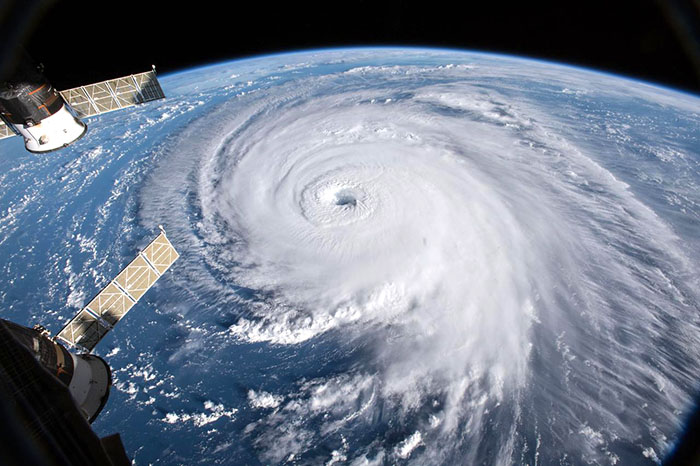
Hurricane Florence as seen from the International Space Station. A high-definition video camera outside the space station captured images as Florence, a Category 4 storm at the time, crossed the Atlantic with winds of 130 miles per hour. Photograph: NASA, 11 September 2018
This sense of specialness and vulnerability is a common theme of astronaut comments. Michael Collins, the third man on Apollo 11, the moon landing expedition which happened less than a year after Apollo 8, has confessed that:
The thing that really surprised me was that it [Earth] projected an air of fragility. Why, I don’t know. I don’t know to this day. I had a feeling it’s tiny, it’s shiny, it’s beautiful, it’s home, and it’s fragile. [6]
while Taylor Wang, the Chinese–American astronaut who flew on Challenger 7 (1985), develops a beautiful analogy:
They say, if you have experiments to run, stay away from the window… it was not until the last day of the flight that I even had a chance to look out. But when I did, I was truly overwhelmed. A Chinese tale tells of some men sent to harm a young girl who, upon seeing her beauty, become her protectors rather than her violators. That’s how I felt seeing Earth for the first time. “I could not help but love and cherish her”. [5, page 60]
The awakening of tenderness and protectiveness has brought about the most evident effect of ‘Earthrise’ to date at a cultural level. In 1968, people were still absorbing Rachel Carson’s seminal work Silent Spring, which revealed for the first time the damaging effect of pesticides upon the ecosystem (see our previous article). The image of the earth as a living, fragile entity, alone in the vastness of space, was catalytic. “That one picture exploded in the consciousness of humans”, said Al Gore in his 2006 film An Inconvenient Truth. “It led to dramatic changes. Within 18 months of this picture, the environmental movement was born.” [7]
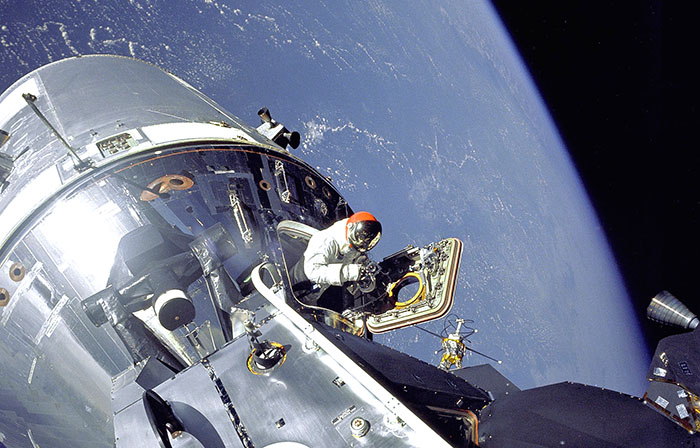
Apollo 9: Commander module pilot David Scott’s extravehicular activity (EVA) on the fourth day of their mission. This photograph was taken by Russell Schweickart, lunar module pilot, from the porch of the module. Inside was astronaut James A. McDivitt. Photograph: NASA, 3 June 1969
The Overview Effect
.
An abrupt change of perspective has been so commonly experienced by astronauts that it is now recognised as new psychological phenomenon, ‘The Overview Effect’ (see video right or below for an extended exposition). The term was first coined by Frank White in his 1987 book of the same name [8] and it has since become a subject of serious study, not least because as we start to think about longer space journeys to Mars and beyond, it is a strong positive in a situation where there are many negatives – fear, loneliness, stress, dealing with weightlessness and cramped living spaces over long periods of time, interpersonal problems, etc. By contrast, the overview effect produces a sense of well-being and fulfilment, which in turn has measurable benefits for both the mind and the cardiovascular system.
Video: The Overview Effect. 19:02 minutes
One of its main features has been identified by researchers as ‘awe’. This is defined as “the intense emotion resulting from the perception of something vast”, bringing about feelings of “wonder, reverence, humility and unity”. [4] The awe experienced by astronauts differs from the feeling we might experience when viewing the vastness of any earthly feature – even the greatness of the Grand Canyon or the Himalayas – because it also includes a sense of totality; seeing things as whole, whether that be the earth, the ecosystem, humankind or the universe itself. It is, as Edgar Mitchell has put it “instant global consciousness”. This experience in itself changes people, and like the crew of Skylab IV, they need time to absorb it.
But for some people, there is even more. The overview effect can trigger what psychologists now call ‘self-transcendent experiences’ in which people undergo a temporary change of identity – a release from the individual self – leading to a sense of deep connection with others. These experiences are likened by researchers to states of spiritual transformation – “which” they remind us, “have historically been associated with practices such as prayer, meditation, and religious rituals as well as the use of psychedelic drugs”. [4] One of the most striking examples of such an experience is recounted by astronaut Russell Schweickart, a crew member on the Apollo 9 mission (1969):
I had five minutes when I was outside on the EVA [extravehicular activity] because of a camera failure and I had nothing to do. I decided that I was going to be just a human being for those five minutes and not an astronaut. So I spent the time just looking at this incredible scene, and one of the many questions that came up was: What does it mean when I say ‘I’? Am I just me, or – looking at life and the earth – am I ‘us’? [9]
In Kevin Kelley’s beautiful book The Home Planet, [5] from which many quotes in this article have been taken, he talks further about what he means by this sense of ‘us’:
You look down and see the surface of that globe that you’ve lived on all this time, and you know all those people down there, and they are like you, they are you, and somehow you represent them. You are up there as a sensing element, that point out on the end, and that’s a humbling feeling. It’s a feeling that says you have a responsibility. It’s not for yourself. The eye that does not see does not do justice to the body. That’s why it’s there; that’s why you are out there. And somehow you recognize that you are part of that total life…
And when you come back, there is a difference in the world now. There’s a difference in the relationship between you and the planet and … all those other forms of life on that planet. [5, page 144]
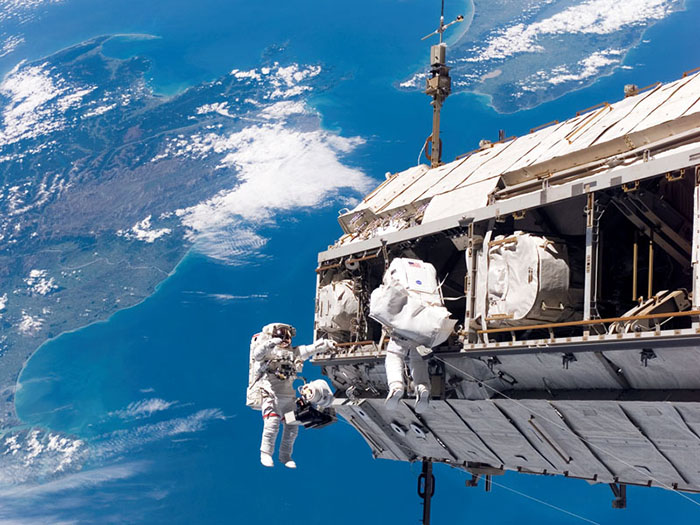
The International Space Station (ISS). Astronauts Robert Curbeam (USA) and Christer Fuglesang (Sweden) work to attach a new truss segment. The station is so large that it could not be launched all at once, and so was built piecemeal, with large sections added continually by flights of the space shuttle. Photograph: STS-116 crew, NASA. Astrology Picture of the Day (APOD) 25 December 2006
Contemporary Experiences
.
The early astronauts spent relatively little time in space, with most of the Apollo missions lasting just a few days. Since then, with the establishment of space stations, it has become common for people to remain for much longer periods in the earth’s orbit. The current record-holder is Russian astronaut Valeri Polyakov, who spent 437 continuous days on Soyuz TM-18/20 in 1994/5, whilst Gennadi Podolka has clocked up a total of 878 days – two and a half years – over six stints. [3]
But familiarity does not seem, in this case, to lessen the effect – on the contrary. In a recent TV series One Strange Rock [10], which documents contemporary developments in space, Chris Hadfield, the Canadian astronaut who served as commander of the ISS, recounts:
One of the biggest changes I found in myself as a result of flying in space was that the difference between ‘us’ and ‘them’ disappears. Somehow going round the world in 92 minutes not just once but over and over again, turned the entire world into one shared place. I think it is a perspective that seeps into astronauts. I think it’s a perspective that’s kinda good for everybody. [10]
In the same series, the American astronaut Peggy Whitson, who spent a total of 666 days in space before her retirement in 2017, explains:
As I’ve grown up and gone to college and gone to graduate school, home has expanded from Iowa to Texas to the United States. But since being in space, home is actually planet Earth. [10]
And in a vivid description of the sudden transition in consciousness which is the essence of the overview effect, she goes on:
The first thing we want to do [when we go into space] is check out the view. Going into space is like I lived my whole life in a semi-dark room, and [then] somebody flipped on the lights. [10]
What is more, the experience seems to produce lasting changes, increasing people’s sense of unity with others and their altruistic tendencies when they return home. As Boris Volynov said after his flights on Soyuz 5 and 21 (1969 and 1976):
During space flight, the psyche of each astronaut is reshaped. Having seen the sun, the stars, and our planet, you become more full of life, softer. You begin to look at all living things with greater trepidation and you begin to be more kind and patient with the people around you. At any rate, that is what happened to me. [5, page 88]
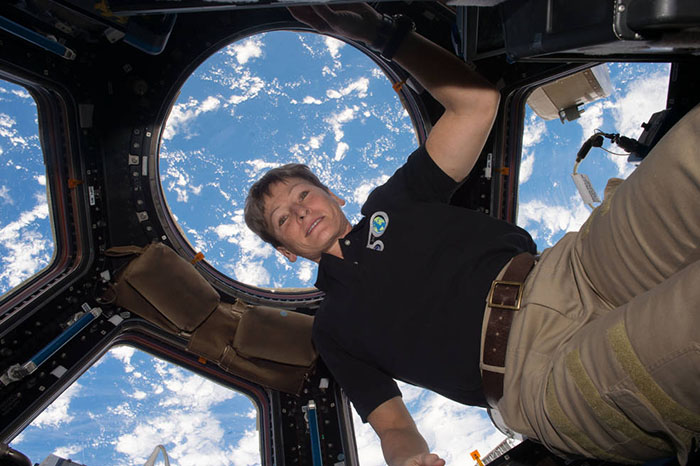
Peggy Whitson, the American astronaut who was has spent 666 days in space, in front of the Cupola windows of the International Space Station. Photograph: NASA, 18 July 2017
Reflections
.
There is no doubt that there are enormous contradictions in the space programme. Whatever might be said about “one giant step for mankind”, the Apollo missions were strongly motivated by cold war rivalry with Russia; one of the main tasks assigned to Armstrong and Aldrin was to plant an American flag on the moon. Once the race was won, political interest waned and NASA funding was dramatically cut. Nowadays, exploration of the moon – and indeed many aspects of space travel – is largely left to commercial interests, either for tourism or exploitation of resources.
Similarly, no one following the recent coverage of the first moon landing could fail to see how the event, watched at the time by an audience of over 600 million worldwide, touched people and brought them together. But fifty years on it is hard to perceive any lasting result of this shared moment of unity. We seem to be as divided as we have ever been.
One of the problems, perhaps, is that the psychologists tell us that in order to really experience the overview effect, you have be there yourself, in person, looking down upon the earth. Contemplating an image is not the same. This means that even if people like Elon Musk were to succeed in establishing space tourism, the vast majority of us will never have the first-hand experience, and so never truly undergo the change of perspective that the overview seems to catalyse.
But having spent the last weeks looking at picture after picture of Earth from space, every one of them testifying to the almost unbelievable beauty and preciousness of our planet, I find it hard to believe that these images do not have a profound effect. Even at second hand, the perspective – to paraphrase Chris Hadfield – “seeps into us”. The British astronomer Fred Hoyle, writing in 1948, maintained that:
Once a photograph of the Earth, taken from outside, is available, once the sheer isolation of the Earth becomes known, a new idea as powerful as any in history will be let loose.
He was surely right, even if the full impact of this new idea has not yet been felt.
But in a way, it is not new. As researchers into the overview effect have noted, the idea of unity – one earth, one people, one ‘I’ and even, in the end, one reality – has been a foundational principle of the spiritual/mystical traditions throughout the ages, and it has been realised and lived by people of wisdom. All that has changed now is the mode in which we know it – as a physical reality as well as in the imagination. From this point of view, these brave astronauts are simply bearing witness – acting, as Rusty Schweickart puts it, as our “sensing element”, our “eye” – to a truth which is already deeply embedded in our psyche. Rakesh Sharma, the Indian astronaut who served on Soyuz T-11, describes the situation like this:
My mental boundaries expanded when I viewed the Earth against a black and uninviting background, yet my country’s rich traditions had conditioned me to look beyond man-made boundaries and prejudices. One does not have to undertake a space flight to come by this feeling. [5, page 80]
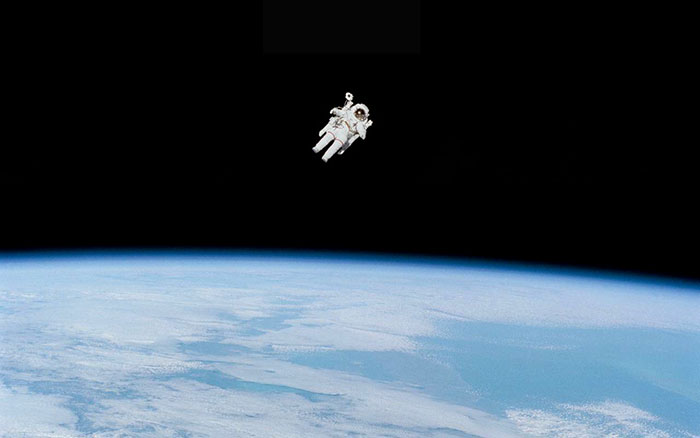
Astronaut Bruce McCandless photographed during the first of his two space shuttle missions. He went ‘free-flying’ to a distance of 320 feet away from the shuttle, using a jet pack called the Manned Maneuvering Unit, or MMU. He and his colleague Robert Stewart were photographed by fellow crew-members in Challenger’s cabin. Photograph: NASA, 2 November 1984
And looking the other way… We should not forget that astronauts sit between two wonderful views; on the one hand, they look back upon their home planet, and on the other they look out into the vastness of space. Since the 1960s, we have added many additonal ‘eyes’ to our preception of the universe through international projects such as the Hubble Telescope and probes into the outer reaches of the solar system. Every day, NASA makes available a new wonder from this exploration as Astronomy Picture of the Day (APOD). The picture below was the APOD for 2nd August 2019 when this article was published; you can see the current picture by clicking on the button below.
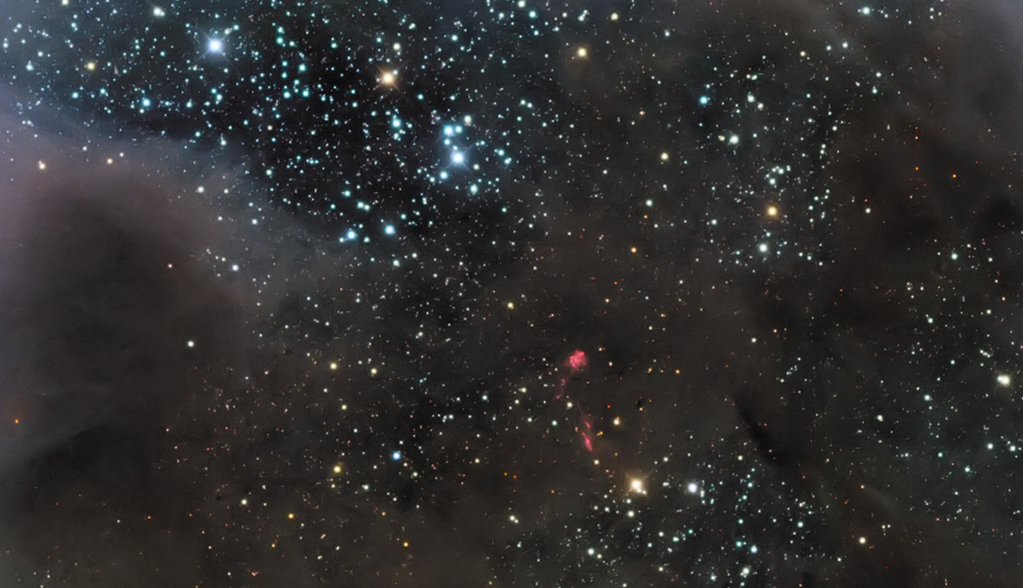
Chamaelean II dark nebula, about 500 light years from Earth. Photograph: Dan Goldman/NASA
Image Sources (click to close)
Banner picture: ‘Earthrise’ taken by Apollo 8 astronaut William Anders on 24 December 1968.
First insert picture: ‘Earthrise’ in its original orientation.
Other Sources (click to open)
now[1] BILL ANDERS: ‘50 Years After Earthrise – A Christmas Eve Message from Its Photographer’ on space.com
[2] EMMANUEL VAUGHAN-LEE: ‘Earthrise: the image that shared our world’ on Global Oneness Project [/]
[3] Astronaut/Cosmonaut Statistics [/]
[4] BRYCE YADEN et al.: ‘The Overview Effect; Awe and Self-Transcendent Experience in Space Flight’, in Psychology of Consciousness: Theory, Research, and Practice 3(1):1–11 March 2016. Click here [/].
[5] KEVIN W. KELLEY: The Home Planet (Addison-Wesley Publishers, 1988).
[6] KENNETH CHANGE: ‘For Apollo 11 He Wasn’t on the Moon. But His Coffee Was Warm’, in The New York Times, 16 July 2019.
[7] JULIETTE JOWIT: ‘How astronauts went to the Moon and ended up discovering planet Earth’, in The Guardian, 20 December 2008. Click here [/].
[8] FRANK WHITE: The Overview Effect: Space Exploration and Human Evolution (American Institute of Aeronautics and Astronautics, 2014).
[9] ‘The Infinite Moonkey Cage’, on BBC Radio 4, broadcast 20 July 2019 (see here [/]).
[10] PROTOZOA PICTURES: One Strange Rock, a 10-part television series first shown on National Geographic Channel beginning March 2018. Click here [/], also available now on Netflix.

Jane Clark is a teacher, researcher and editor living in Oxford. She has been involved in the study of mysticism, particularly the work of the Andalusian philosopher/mystic Muhyiddin Ibn ‘Arabi, for nearly forty years. She has a special interest in the relevance of traditional teachings to contemporary thought; she was a founder editor of The Journal of Consciousness Studies and is currently editor of Beshara Magazine
Email this page to a friend
FOLLOW AND LIKE US
Video: Earthrise: The Story Behind William Anders’ Apollo 8 Photograph. 5:04 minutes
——————————————
——————————————
——————————————
Video: The Overview Effect. 19:02 minutes
FOLLOW AND LIKE US
If you enjoyed reading this article
Please leave a comment below.
Please also consider making a donation to support the work of Beshara Magazine. The magazine relies entirely on voluntary support. Donations received through this website go towards editorial expenses, eg. image rights, travel expenses, and website maintenance and development costs.
READ MORE IN BESHARA MAGAZINE
A Thing of Beauty…
David Hyams describes the creation of a new ark for the Synagogue in Oxford, UK
A Thing of Beauty…
Mark Boston reflects on painting the film Loving Vincent
A Thing of Beauty…
David Apthorp praises the Sokollu Mehmet Pasha Mosque in Istanbul
READERS’ COMMENTS





It is a pleasure to read this weblog, thanks to its up-to-date information and interesting posts. Look into my web page Webemail24 for some really good points and find out more about Search Engine Optimization.
An excellent read that will keep readers – particularly me – coming back for more! Also, I’d genuinely appreciate if you check my website Seoranko about SEO. Thank you and best of luck!
Sharing is caring the say, and you’ve done a fantastic job in sharing your knowledge on your blog. It would be great if you check out my page, too, at Articlecity about Search Engine Optimization.